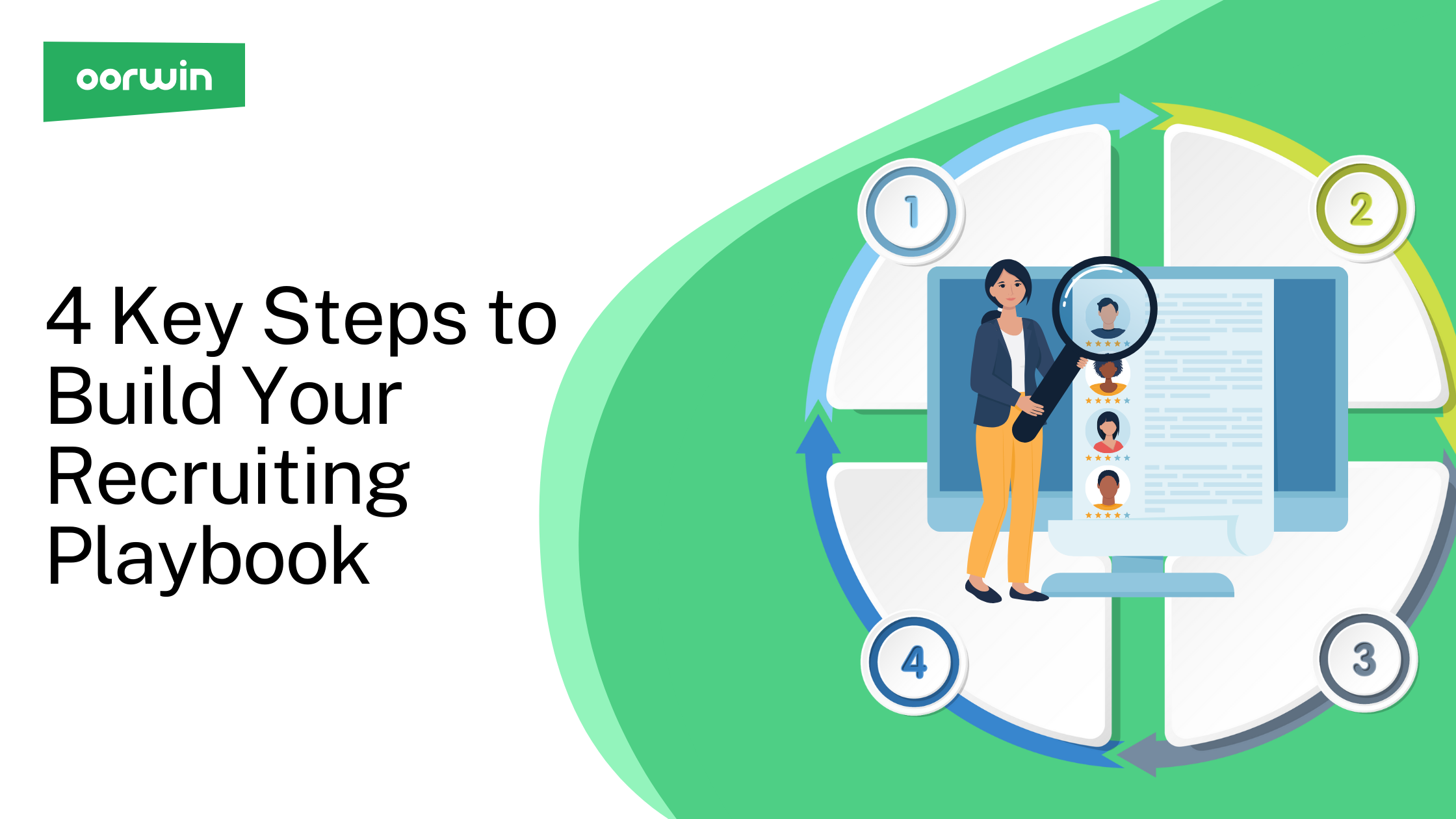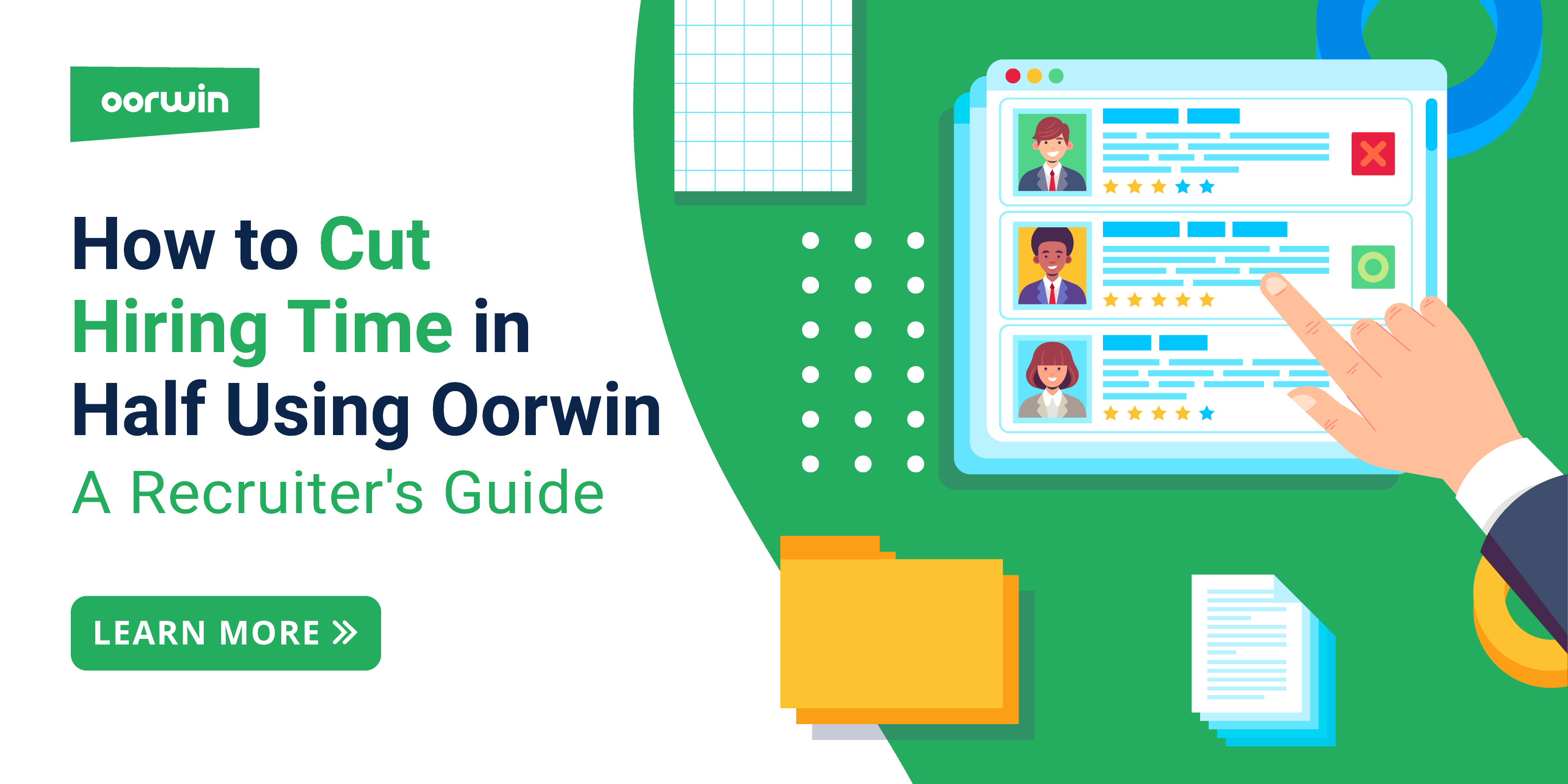4 Key Steps to Build Your Recruiting Playbook in 2024
Oorwin
9min read / 28 Feb 2024

Related Articles
Building a 4-Step Recruiting Playbook in 2024
Recruiting top talent is more strategic than ever in 2024. With the employment landscape constantly evolving, companies must adapt to stay competitive. A well-structured recruitment playbook is key to streamlining your hiring process, ensuring you attract and retain the best candidates.
In today’s competitive job market, a strategic approach to recruitment is not just beneficial; it’s essential. Crafting a recruitment playbook in 2024 requires understanding the latest trends and technologies. It’s about building a cohesive strategy that aligns with your company’s goals, culture, and the dynamic needs of the workforce. This guide will provide the tools and insights needed to develop a robust recruiting playbook, ensuring your organization remains at the forefront of talent acquisition.
Introduction to Strategic Recruiting
Strategic recruiting transcends mere vacancy filling; it anticipates organizational needs, proactively meeting them. In 2024, it will involve data leverage, comprehension of market dynamics, and candidate-centric process creation. A strategy-based recruitment playbook boosts your ability to attract elite candidates, elevating your company’s desirability as an employer. This approach ensures your recruitment efforts are not just about filling positions but strategically securing the talent necessary for your organization’s growth and success in a competitive job market.
Step 1: Assemble the Right Team
Creating an effective recruitment team is pivotal. Choose members for their diverse skills, perspectives, and a shared commitment to identifying the best talent. This foundational step ensures a broad and insightful approach to candidate evaluation, setting the stage for strategic hiring success.
Identifying Key Voices for Your Interview Committee
The success of a recruitment playbook hinges on the composition of your interview committee. Selecting key voices from various company sectors ensures a comprehensive evaluation of candidates. This diversity in perspectives enriches the recruitment process, offering deeper insights into each candidate’s compatibility with your organizational culture and values. Such a meticulously chosen committee can significantly enhance the selection process, ensuring the best fit for both the role and the company.
Fostering Collaboration and Insight
Strategic recruitment thrives on collaboration. A collaborative interview committee, open to sharing insights and perspectives, makes more informed hiring decisions. Encouraging open dialogue and mutual respect among members maximizes their collective expertise. This approach not only improves the quality of hiring decisions but also promotes a culture of inclusivity and respect, which is critical for attracting and retaining top talent.
Step 2: Establish Clear Evaluation Criteria
A strategic recruitment playbook requires clear, objective evaluation criteria to streamline the hiring process. Defining specific skills, experiences, and characteristics for each role ensures a fair and efficient evaluation process, a key strategy within the playbook. This step accelerates the hiring process and improves hire quality, which is foundational to the recruitment playbook.
Creating a Focused List of Qualifications
Essential to any recruitment playbook, a focused list of qualifications tailored to each position outlines the necessary skills and attributes. Establishing these criteria, a core playbook strategy, focuses on the most promising applicants, enhancing the recruitment process’s effectiveness and ensuring alignment with the playbook’s goals.
Implementing and Ranking Criteria
Within the recruitment playbook, implementing and ranking evaluation criteria offer a structured candidate assessment approach. Prioritizing qualifications based on their importance to the role allows for nuanced comparisons, a strategy central to the playbook. This systematic evaluation aligns the hiring process with organizational goals, reducing biases and enhancing decision-making efficiency, which is key to the recruitment playbook’s strategic framework.
These steps, foundational to the recruitment playbook, ensure that the recruitment process is not only efficient but also strategically aligned with the organization’s broader objectives. As the recruitment landscape evolves, these strategic elements of the recruitment playbook remain vital for companies aiming to attract and retain top talent in 2024 and beyond.
Step 3: Adhere to a Strict Timeline
A strict timeline is crucial within a recruitment playbook to minimize the impact of vacancies and maintain momentum. This step involves setting clear deadlines for each phase of the recruitment process, a strategy that ensures efficiency and effectiveness. Communicating these timelines internally and to candidates is key, aligning expectations and keeping the process on track. Adhering to a strict timeline not only expedites the hiring process but also demonstrates respect for candidates’ time, a principle central to the recruitment playbook’s philosophy.
The Impact of Vacancies and Timeline Communication
Vacancies can significantly affect an organization’s productivity and morale, making timeline adherence a strategic priority in the recruitment playbook. Effective communication about the recruitment timeline mitigates these impacts, ensuring that all stakeholders are informed and engaged. This strategy enhances the recruitment process’s transparency and efficiency, the core aims of the recruitment playbook, fostering a positive experience for all involved.
Maintaining the Schedule and Keeping Candidates Informed
A recruitment playbook emphasizes the importance of maintaining the recruitment schedule and keeping candidates informed. This approach ensures that the recruitment process remains efficient and candidates feel valued and respected. Transparent communication is a strategic element of the playbook, enhancing the candidate experience and supporting the organization’s reputation as an employer of choice.
Step 4: Conduct Parallel Candidate Interviews
Parallel candidate interviews are a strategic approach highlighted in the recruitment playbook to streamline the interview process. By conducting interviews simultaneously, organizations can quickly identify the most promising candidates, reducing the time to hire. This method requires careful planning and coordination but is a game-changer in making the recruitment process more efficient, a key goal of the recruitment playbook.
Rationale and Planning for Parallel Interviews
The rationale behind parallel interviews, as outlined in the recruitment playbook, is to maximize efficiency and minimize the time vacancies remain unfilled. Planning for parallel interviews involves scheduling and resource allocation, ensuring that each candidate receives adequate attention. This strategy, integral to the recruitment playbook, enables a swift comparison of candidates, accelerating the decision-making process.
Executing Efficient Interview Days
Executing efficient interview days is essential for the success of parallel interviews, a strategy advocated by the recruitment playbook. This involves meticulous scheduling, interviewer preparation, and ensuring a positive candidate experience. The efficient execution of interview days reflects the recruitment playbook’s emphasis on respect for candidates’ time and the desire to optimize the recruitment process.
Execution and Feedback: The Path to Strategic Hiring
Execution and feedback are pivotal in the recruitment playbook, turning strategic plans into successful hires. Effective implementation and iterative improvement, informed by feedback, refine hiring strategies, ensuring adaptability and success in a dynamic job market.
1. The Role of Execution and Continuous Improvement
Effective execution is crucial in realizing the goals of a recruitment playbook. It’s about putting plans into action and adapting based on outcomes. Continuous improvement is key, with participant feedback enhancing strategies for future success. This cycle of execution and refinement ensures the recruitment playbook remains relevant and effective, aligning hiring practices with organizational goals and market changes.
2. Using Partnerships to Improve Hiring
Incorporating partnerships into the recruitment playbook can significantly boost hiring success. Collaborations with agencies, tech providers, and educational institutions bring new perspectives and tools, streamlining the recruitment process. These partnerships extend the capabilities of the recruitment playbook, offering access to broader talent pools and innovative recruitment technologies, thereby enhancing strategic hiring outcomes.
Improve Every Step of Your Hiring Journey with Oorwin
In conclusion, Oorwin enhances every phase of your recruitment playbook, making it a formidable asset for strategic recruiters. Through adherence to structured steps and the integration of continuous feedback, Oorwin ensures your hiring process is both efficient and effective.
It’s not merely about filling vacancies; it’s about securing and nurturing top-tier talent that propels your organization forward. With Oorwin, elevate your recruitment strategy to meet and exceed the dynamic demands of today’s competitive talent landscape.
FAQ
Why is a recruiting playbook essential for a successful hiring strategy?
A recruiting playbook is essential for a successful hiring strategy as it provides a structured, consistent approach to recruitment, ensuring alignment with organizational goals and efficient candidate evaluation, ultimately improving the quality of hires and streamlining the hiring process.
How can I tailor a recruiting playbook to fit the unique needs of my organization?
To tailor a recruiting playbook to your organization’s unique needs, identify specific goals, challenges, and cultural aspects. Incorporate flexible strategies that address these unique elements, allowing for customization of evaluation criteria, interview processes, and communication methods.
What key elements should be included in a high-impact recruiting playbook?
A high-impact recruiting playbook should include clear objectives, detailed role descriptions, structured interview processes, evaluation criteria, timelines, feedback mechanisms, and strategies for diversity and inclusion. These elements ensure a comprehensive and strategic approach to talent acquisition.
How can technology and tools enhance the effectiveness of a recruiting playbook?
Technology and tools enhance a recruiting playbook by automating repetitive tasks, improving communication, facilitating candidate evaluation, and offering data-driven insights. They enable more efficient candidate sourcing, tracking, and engagement, making the recruitment process faster and more effective.
Popular Articles..
Blog

10min read / 25-Jun-2025
Master Effective Interview Techniques with Oorwin: A Step-by-Step Recruiter’s Guide
Blog
Blog
Get the latest Oorwin releases, updates, success stories & industry news
 Back
Back



